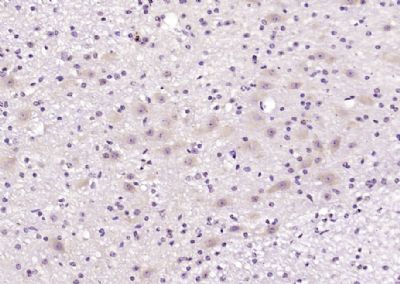PAM16 Polyclonal Antibody
Purified Rabbit Polyclonal Antibody (Pab)
- SPECIFICATION
- CITATIONS
- PROTOCOLS
- BACKGROUND

Application
| WB, IHC-P, IHC-F, IF, ICC, E |
|---|---|
| Primary Accession | Q9Y3D7 |
| Reactivity | Rat, Pig, Dog, Bovine |
| Host | Rabbit |
| Clonality | Polyclonal |
| Calculated MW | 14 KDa |
| Physical State | Liquid |
| Immunogen | KLH conjugated synthetic peptide derived from human PAM16 |
| Epitope Specificity | 31-125/125 |
| Isotype | IgG |
| Purity | affinity purified by Protein A |
| Buffer | 0.01M TBS (pH7.4) with 1% BSA, 0.02% Proclin300 and 50% Glycerol. |
| SUBCELLULAR LOCATION | Mitochondrion inner membrane. |
| SIMILARITY | Belongs to the TIM16/PAM16 family. |
| SUBUNIT | Probable component of the PAM complex at least composed of a mitochondrial HSP70 protein, GRPEL1 or GRPEL2, TIMM44, TIMM16/PAM16 and TIMM14/DNAJC19 (By similarity). Interacts with DNAJC19. Directly interacts with DNAJC15; this interaction counteracts DNAJC15-dependent stimulation of HSPA9 ATPase activity. Associates with the TIM23 complex. |
| Important Note | This product as supplied is intended for research use only, not for use in human, therapeutic or diagnostic applications. |
| Background Descriptions | This gene encodes a mitochondrial protein involved in granulocyte-macrophage colony-stimulating factor (GM-CSF) signaling. This protein also plays a role in the import of nuclear-encoded mitochondrial proteins into the mitochondrial matrix and may be important in reactive oxygen species (ROS) homeostasis. Mutations in this gene cause Megarbane-Dagher-Melike type spondylometaphyseal dysplasia, an early lethal skeletal dysplasia characterized by short stature, developmental delay and other skeletal abnormalities. [provided by RefSeq, May 2017] |
| Gene ID | 51025 |
|---|---|
| Other Names | Mitochondrial import inner membrane translocase subunit TIM16, Mitochondria-associated granulocyte macrophage CSF-signaling molecule, Presequence translocated-associated motor subunit PAM16, PAM16, MAGMAS, TIM16, TIMM16 |
| Target/Specificity | Ubiquitously expressed. |
| Dilution | WB=1:500-2000,IHC-P=1:100-500,IHC-F=1:100-500,ICC=1:100-500,IF=1:100-500,ELISA=1:5000-10000 |
| Storage | Store at -20 ℃ for one year. Avoid repeated freeze/thaw cycles. When reconstituted in sterile pH 7.4 0.01M PBS or diluent of antibody the antibody is stable for at least two weeks at 2-4 ℃. |
| Name | PAM16 |
|---|---|
| Synonyms | MAGMAS, TIM16, TIMM16 |
| Function | Regulates ATP-dependent protein translocation into the mitochondrial matrix. Inhibits DNAJC19 stimulation of HSPA9/Mortalin ATPase activity. |
| Cellular Location | Mitochondrion inner membrane; Peripheral membrane protein; Matrix side |
| Tissue Location | Ubiquitously expressed. |

Thousands of laboratories across the world have published research that depended on the performance of antibodies from Abcepta to advance their research. Check out links to articles that cite our products in major peer-reviewed journals, organized by research category.
info@abcepta.com, and receive a free "I Love Antibodies" mug.
Provided below are standard protocols that you may find useful for product applications.
If you have used an Abcepta product and would like to share how it has performed, please click on the "Submit Review" button and provide the requested information. Our staff will examine and post your review and contact you if needed.
If you have any additional inquiries please email technical services at tech@abcepta.com.













 Foundational characteristics of cancer include proliferation, angiogenesis, migration, evasion of apoptosis, and cellular immortality. Find key markers for these cellular processes and antibodies to detect them.
Foundational characteristics of cancer include proliferation, angiogenesis, migration, evasion of apoptosis, and cellular immortality. Find key markers for these cellular processes and antibodies to detect them. The SUMOplot™ Analysis Program predicts and scores sumoylation sites in your protein. SUMOylation is a post-translational modification involved in various cellular processes, such as nuclear-cytosolic transport, transcriptional regulation, apoptosis, protein stability, response to stress, and progression through the cell cycle.
The SUMOplot™ Analysis Program predicts and scores sumoylation sites in your protein. SUMOylation is a post-translational modification involved in various cellular processes, such as nuclear-cytosolic transport, transcriptional regulation, apoptosis, protein stability, response to stress, and progression through the cell cycle. The Autophagy Receptor Motif Plotter predicts and scores autophagy receptor binding sites in your protein. Identifying proteins connected to this pathway is critical to understanding the role of autophagy in physiological as well as pathological processes such as development, differentiation, neurodegenerative diseases, stress, infection, and cancer.
The Autophagy Receptor Motif Plotter predicts and scores autophagy receptor binding sites in your protein. Identifying proteins connected to this pathway is critical to understanding the role of autophagy in physiological as well as pathological processes such as development, differentiation, neurodegenerative diseases, stress, infection, and cancer.


